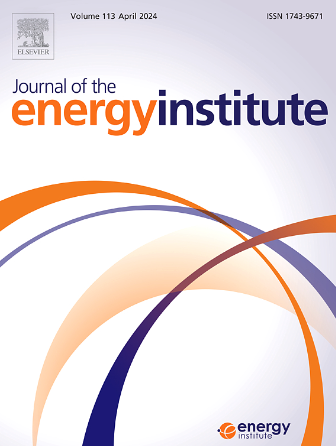微藻与工业废水共液化:温度对产品产率和品质的影响
IF 5.6
2区 工程技术
Q2 ENERGY & FUELS
引用次数: 0
摘要
本研究探讨了水热液化(HTL)温度(120-240℃)对微藻工业废水系统中产物分布和特征的影响,突出了其在调节水解、热解和缩聚过程中的作用。液相产率仍占主导地位(96.07 - 97.48%),但随着温度的升高,其产率下降了1.36%,而在240℃时,由于纤维素脱水和蛋白质交联,固相产率显著提高。水相分析表明,240°C时,化学需氧量(COD)峰值约为10,000 mg/L,这是由于脂质脱羧和美拉德反应增强了有机物的溶解。在210°C以上,铵态氮(NH4+-N)显著增加,这与蛋白质脱胺作用有关,而磷酸盐(PO43−)由于无机磷沉淀而保持在较低水平。结构分析表明,温度升高促进了碳芳构化,C-C键在180℃时达到73.31%的峰值,石墨- n含量在240℃时增加到38.19%。生物原油组成分析表明,在150 ~ 180℃时,中链烷烃(c6 ~ c12)和含氧化合物含量最多,240℃时,长链烷烃(c12 ~ c20)含量最多,氮化合物因氨挥发而减少。这些结果表明,150-180°C是生物油生产的最佳温度,而240°C有利于功能碳材料的合成。本文章由计算机程序翻译,如有差异,请以英文原文为准。

Co-liquefaction of microalgae and industrial wastewater: The impact of temperature on product yield and quality
This study explored the impact of hydrothermal liquefaction (HTL) temperature (120–240 °C) on the distribution and characteristics of products in a microalgae industrial wastewater system, highlighting its role in regulating hydrolysis, pyrolysis, and polycondensation processes. While the liquid phase yield remained dominant (96.07–97.48 %), it decreased by 1.36 % with increasing temperature, and the solid phase yield significantly increased at 240 °C due to cellulose dehydration and protein cross-linking. Aqueous phase analysis revealed that chemical oxygen demand (COD) peaked at around 10,000 mg/L at 240 °C, attributed to the enhanced dissolution of organic matter through lipid decarboxylation and the Maillard reaction. Ammonium nitrogen (NH4+-N) increased notably above 210 °C, linked to protein deamination, while phosphate (PO43−) remained low due to inorganic phosphorus precipitation. Structural analysis of the hydrochar showed that elevated temperatures promoted carbon aromatization, with C-C bonds reaching their peak at 73.31 % at 180 °C and Graphitic-N content increasing to 38.19 % at 240 °C. Bio-crude oil composition analysis indicated that medium-chain alkanes (C6-C12) and oxygenated compounds were most abundant at 150–180 °C, while long-chain alkanes (C12-C20) dominated at 240 °C, and nitrogen compounds decreased due to ammonia volatilization. These findings suggest that 150–180 °C is optimal for bio-oil production, while 240 °C favors functional carbon material synthesis.
求助全文
通过发布文献求助,成功后即可免费获取论文全文。
去求助
来源期刊

Journal of The Energy Institute
工程技术-能源与燃料
CiteScore
10.60
自引率
5.30%
发文量
166
审稿时长
16 days
期刊介绍:
The Journal of the Energy Institute provides peer reviewed coverage of original high quality research on energy, engineering and technology.The coverage is broad and the main areas of interest include:
Combustion engineering and associated technologies; process heating; power generation; engines and propulsion; emissions and environmental pollution control; clean coal technologies; carbon abatement technologies
Emissions and environmental pollution control; safety and hazards;
Clean coal technologies; carbon abatement technologies, including carbon capture and storage, CCS;
Petroleum engineering and fuel quality, including storage and transport
Alternative energy sources; biomass utilisation and biomass conversion technologies; energy from waste, incineration and recycling
Energy conversion, energy recovery and energy efficiency; space heating, fuel cells, heat pumps and cooling systems
Energy storage
The journal''s coverage reflects changes in energy technology that result from the transition to more efficient energy production and end use together with reduced carbon emission.
 求助内容:
求助内容: 应助结果提醒方式:
应助结果提醒方式:


